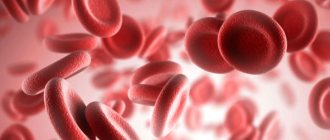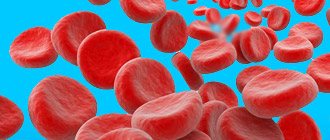Hyperchromic anemia
– a group of blood diseases with a color index above 1.15, characterized by impaired hematopoietic function.
Hyperchromic macrocytic anemia includes the following diseases:
— B12-deficiency anemia;
— Folate deficiency anemia;
— Myeloplastic syndrome.
- Symptoms of folate deficiency anemia
- Symptoms of myelodysplastic syndrome
What can cause hyperchromia?
The reasons for the decrease in the concentration of vitamin B12 in the body are associated with various factors.
Insufficient food intake - restriction in food intake of meat, vegetables and fruits due to hunger, different diets, vegetarianism, and lack of financial opportunity to eat rationally.
Impaired absorption in various gastrointestinal diseases:
- the development of atrophic gastritis in older people is associated with impaired production of gastromucoprotein (internal Castle factor), necessary for the absorption of vitamin from food; this type of anemia is called pernicious;
- diseases affecting the small and large intestines (enterocolitis, chronic dysentery, condition after resection of part of the intestine) disrupt the absorption function of the wall;
- infectious and helminthic lesions of the intestines, in which food vitamins serve as food for pathological pathogens and parasites.
Folate deficiency rarely occurs because the body uses it in very small quantities and the supply lasts for a long time.
The main causes of folate deficiency anemia are:
- alcoholism with damage to liver cells;
- inflammatory liver diseases (hepatitis);
- pregnancy and breastfeeding without adequate nutritional compensation for the mother.
Causes
In medicine, there are 2 types of this type of anemia: megaloblastic and non-megaloblastic. The reasons will vary depending on what type is diagnosed. The megaloblastic species is characterized by a disruption in the production of DNA and RNA.
As a result of a malfunction in the bone marrow, cells called megaloblasts appear.
Causes of hyperchromic anemia (megaloblastic type):
- Presence of MDS syndrome. This is a type of bone marrow disease that occurs due to mutations in the blood stem cell.
- It may develop due to the use of certain medications, for example, Zidovudine, Azathioprine.
- AIDS
Non-megaloblastic anemia is a disease in which DNA production occurs normally and there are no megaloblasts in the bone marrow. This anemia may occur due to:
Find the answer
Are you having any problem? Enter “Symptom” or “Name of the disease” into the form, press Enter and you will find out all the treatment for this problem or disease.
- Liver diseases;
- Various tumors;
- Alcohol addiction;
- Diseases of the thyroid gland.
Mechanisms of hematopoietic damage
Vitamin B12 and folates (folic acid salts) perform an important function in the synthesis of cell DNA: they are essential enzymes, without which the biochemical process stops. It is impossible to accumulate a sufficient amount in the liver. The body needs constant replenishment of the necessary components.
Pathology develops gradually when all reserves are exhausted. During the process of hematopoiesis, the division of erythroblast cells is disrupted. They turn into megaloblasts. A similar type of erythrocyte germ was present in humans in the embryonic state.
Clinical manifestations
The symptoms of hyperchromic anemia are characterized by a small number of patient complaints, despite the pallor and tired appearance. Anemia can be diagnosed when visiting for pain in the heart or during an examination of the stomach.
The patient’s weight loss is not typical for this form; on the contrary, patients tend to be overweight.
All symptoms are divided into 3 groups.
Manifestations of anemia:
- the patient notices weakness;
- frequent dizziness with tinnitus;
- unmotivated shortness of breath with palpitations occurs;
- at rest, sudden angina pain in the heart is possible;
- the skin color acquires a pale yellow tint, the sclera becomes icteric;
- During auscultation, the doctor can listen to a characteristic systolic murmur in the apical region, and in advanced cases, a systole-diastolic murmur.
Mild yellowing of the sclera indicates anemia
Manifestations of damage to the digestive system include:
- changes in taste sensations, aversion to certain foods;
- decreased appetite;
- burning sensation on the tongue;
- constant heaviness and feeling of fullness in the stomach;
- unstable stool with frequent diarrhea;
- A doctor’s examination reveals a characteristic “crimson tongue” with thick folds and an enlarged liver.
Damage to the nervous system is expressed in numbness of the skin areas, loss of sensitivity in the arms and legs, chilliness of the limbs, muscle weakness and cramps in them.
Folate deficiency does not cause neurological manifestations or gastrointestinal symptoms. The patient notes the usual manifestations of all anemias.
Acute phase
If the disease manifests itself in the acute phase, then the symptoms are more serious.
This can be severe intoxication or bleeding in the internal organs.
Anemia (acute phase) is manifested by the following symptoms:
- The skin looks pale.
- Increased heart rate.
- Low blood pressure.
- Changes in blood vessels.
- Possible internal bleeding.
- Increased intoxication of all organs.
- Unreasonable irritation, nervous condition.
- Weakened vision, dizziness.
- Weak hair and brittle nails.
Blood picture
In peripheral blood it is found:
- a sharp decrease in the number of normal red blood cells;
- moderate leukopenia and thrombocytopenia;
- In the blood smear, various erythrocytes (megalocytes, megaloblasts) changed in structure, size and shape are visible; in them, an experienced laboratory technician finds typical nuclear Jolly bodies and rings (due to the parietal location of the nucleus).
The tongue is distinguished not only by its crimson hue, but also by its smoothness of the pattern and swelling
Hyperchromic anemia in myelodysplastic syndrome
Myelodysplasia syndrome was isolated due to characteristic hyperchromic changes in the blood after chemotherapy and radiation exposure to the bone marrow in the treatment of tumors and leukemia.
In this case, a toxic effect occurs on the process of hematopoiesis in brain cells. Against the background of severe symptoms of the underlying disease, the patient develops:
- dyspnea;
- increased fatigue;
- severe dizziness and tachycardia at the slightest exertion.
The diagnosis is made based on a typical blood picture.
Complications
Low hemoglobin levels also mean lack of oxygen. Because of this, tachycardia develops and blood pressure rises. If treatment is not started, this can lead to degeneration of tissues and organs, circulatory disorders, myocardial dystrophy with an increase in heart size, and heart failure.
Vitamin B12 deficiency causes various neurological diseases.
If the pathology is caused by bone marrow pathologies, there is a risk of developing leukemia.
Treatment
Mild forms are well compensated by changing the diet, introducing into the daily diet foods rich in essential vitamins (meat, especially liver products, fish, cheese, vegetables and fruits). Nutrition is especially important during pregnancy and breastfeeding.
For the treatment of B12 and folate deficiency anemia, there are high-quality synthetic drugs Cyanocobalamin, Oxycobalamin and Folic acid. Depending on the severity of the blood damage, the doctor prescribes an individual dose. Oxycobalamin has greater activity.
Cyanocobalamin is used in intramuscular injections, and Folic acid is used in tablets.
Standard treatment regimen:
- The maximum dose is prescribed to the patient for 1–1.5 months.
- Then another 2 months - maintenance therapy in the form of one injection per week.
- In the subsequent two-month period, a maintenance dose is administered 2 times a month.
An indicator of effectiveness is the appearance of reticulocytosis in a blood test, a week after the start of therapy, and an improvement in the patient’s well-being. Neurological disorders take the longest to recover.
There is an important sign in therapy: if after a week of treatment with synthetic vitamins there is no improvement, this indicates an incorrect diagnosis.
In severe cases of hyperchromic anemia, it is rarely necessary to transfuse red blood cells.
Lack of response to vitamin B12 therapy also serves as a differential sign between folate deficiency anemia and B12 deficiency anemia.
If myelodysplastic syndrome is confirmed in a patient, quick results cannot be expected. Moreover, there is a danger of the disease progressing to acute leukemia. Therapy requires a replacement transfusion of red blood cells and platelets, immunoglobulin and drugs that stimulate differentiated cell division are administered.
The diet of older people must include vegetables, fruits, and lean meat.
Health implications
In childhood, hyperchromic anemia is dangerous due to delayed mental and physical development. The child will be more susceptible to various diseases, his immunity will not be able to cope with infections. Such children get sick for a long time and seriously.
Anemia is dangerous for pregnant women who may experience premature labor. The fetus will suffer from a lack of nutrients, the child may be born with underweight and developmental abnormalities. Therefore, during pregnancy you need to regularly visit an obstetrician-gynecologist.
Other consequences of anemia include: cardiomyopathy, tachycardia, heart failure. Therefore, treatment of this disorder must be timely.
Author of the article:
Shutov Maxim Evgenievich |
Hematologist Education: Graduated from Kursk State Medical University in 2013 and received a diploma in General Medicine. After 2 years, he completed his residency in the specialty “Oncology”. In 2021, she completed postgraduate studies at the National Medical and Surgical Center named after N.I. Pirogov. Our authors
Course of hyperchromic anemia
Timely treatment can prevent possible serious consequences in the form of coma. The patient, following the medication regimen, gradually achieves complete recovery under the supervision of a doctor. In rare cases, if you are deficient in folic acid, you may have to take it continuously for the rest of your life.
Treatment methods for myelodysplastic syndrome are carried out in courses and do not have a long-term effect. They help prolong the period of remission and the life of the patient. In such cases, complete recovery can only be achieved with a bone marrow transplant.
Dispensary observation is carried out by a local therapist quarterly with a control blood test; a consultation with a neurologist is required once a year. A referral and follow-up check at a hematology center is possible.
Prevention of relapses involves following a proper diet and getting rid of factors that contribute to anemia. Given its high prevalence among older people, attention should be paid to the problem of rational nutrition among older people.
Prognosis and prevention
Timely treatment of B12-deficiency anemia in most cases can completely eliminate the hematological disorder. Already on days 4-5, changes in test results can be detected; an increase in hemoglobin and the number of red blood cells is observed on the 7th day. These indicators are completely normalized after 8 weeks.
Neurological symptoms can go away for quite a long time, up to six months. Spinal cord damage associated with anemia is irreversible, so it is very important to promptly consult a doctor: a hematologist or therapist.
Increased attention to the prevention of this disease should be paid to patients who have undergone bariatric surgery or gastrectomy. At risk are vegetarians, people on strict diets with limited meat and offal, pregnant women and women who have recently given birth. Prevention consists of using the B12 drug in the form of tablets or injections; the doctor will select a safe prophylactic dose.







